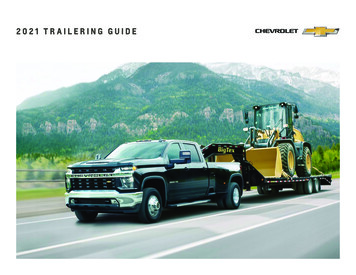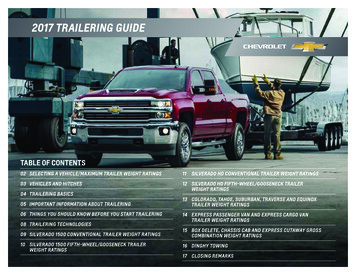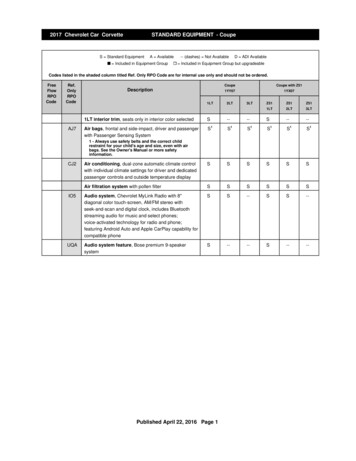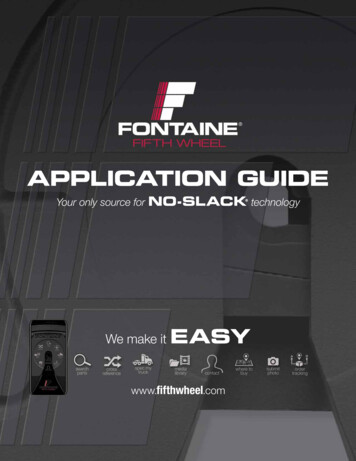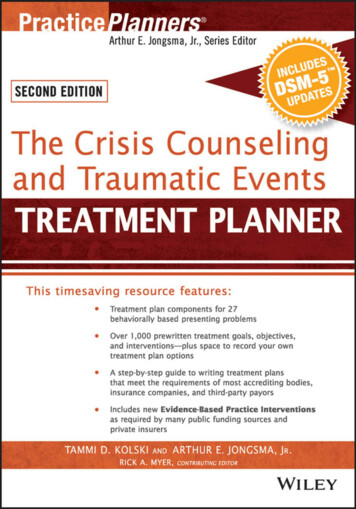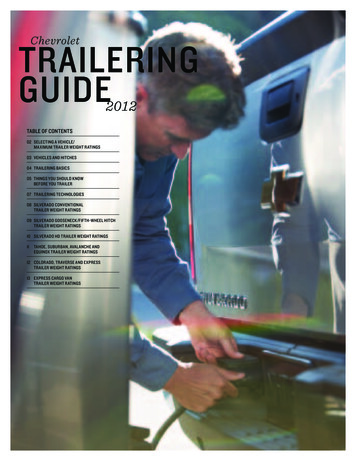
Transcription
ChevroletTRAILERINGGUIDE2012Table of contents02 SELECTING A VEHICLE/Maximum Trailer Weight Ratings03 VEHICLES AND HITCHES04 TRAILERING BASICS05 THINGS YOU SHOULD KNOWBEFORE YOU TRAILER07 Trailering TechnologIES08 SILVERADO CONVENTIONALTRAILER WEIGHT RATINGS09 SILVERADO Gooseneck/Fifth-Wheel HitchTRAILER WEIGHT RATINGS10 SILVERADO HD TRAILER WEIGHT RATINGS11 TAHOE, SUBURBAN, AVALANCHE ANDEQUINOX TRAILER WEIGHT RATINGS12 COLORADO, TRAVERSE AND EXPRESSTRAILER WEIGHT RATINGS13 Express Cargo VanTrailer Weight Ratings
02 SELECTING A VEHICLE/MAXIMUM TRAILER WEIGHT RATINGSCruze2EquinoxTraverseColoradoSilverado HybridExpress 1500Passenger VanTahoe HybridExpress 1500Cargo VanAvalancheSuburban 1/2-tonTahoeSuburban 6,00015,00014,00013,00012,00011,00010,000include the weight of any additional passengers and optionalequipment (driver weight and base equipment are alreadyincluded). See pages 08–13 for maximum trailer weight ratingsby specific 00The chart below gives you an idea of the maximum amountof weight you can confidently and safely trailer with differentChevrolet models when your vehicle is properly equipped.When determining the total weight of trailer and 7008,1008,1008,5009,600Express 2500Passenger Van9,800Express 3500Passenger Van10,000Express 2500/3500Cargo Van10,000Silverado 150010,700Silverado 2500HDSilverado 3500HD17,80023,0001 Maximum trailer weight ratings are calculated assuming a base vehicle, except for any option(s) necessary to achieve the rating, plus driver. The weight of other optionalequipment, passengers and cargo will reduce the maximum trailer weight your vehicle can tow. See your Chevrolet dealer for additional details. 2 Towing not recommendedon Eco model.
03 Vehicles and HitchesHitch Ball on Step-bumperHitch Ball on Draw BarFifth-wheel HitchSELECTING THE RIGHT HITCH Choosing the right hitch andmaking the proper electrical connections affects how yourvehicle handles, corners and brakes, and allows you to alertother drivers of your intentions. Before selecting a hitch ortrailering package, you should be familiar with the weightratings specific to your Chevrolet vehicle, which are detailedon pages 08–13.SELECTING TRAILERING EQUIPMENT Most Chevrolet vehiclesoffer a variety of standard and available equipment forenhanced trailering performance. Aside from the equipmentdescribed below, features such as heavy-duty cooling andextendable trailering mirrors may be available. See yourChevrolet dealer for more information on the model you’reinterested in.WEIGHT-CARRYING HITCH This consists of a hitch ball mountedto a step-bumper or draw bar. Hitch balls are available in arange of sizes. Make sure that the diameter of your hitch ballmatches your trailer coupler. Also check that the ball meetsor exceeds the gross trailer weight rating.WEIGHT-DISTRIBUTING HITCH This hitch type distributes thetrailer tongue load by using spring bars to shift some of thehitch weight forward onto the tow vehicle’s front axle andrearward to the trailer’s axles.FIFTH-WHEEL HITCH AND GOOSENECK HITCH These are designedfor heavy trailering. Located in the bed of the truck, thesehitches position the trailer’s kingpin weight over, or slightlyin front of, the truck’s rear axle. Fifth-wheel and gooseneckhitches are most frequently used with travel trailers, horsetrailers and other large trailers.HITCHES It’s important to have the correct hitch equipment. If you’ll be towing a trailer that requires a weightdistributing hitch, be sure to use a frame-mounted,weight-distributing hitch 1 and sway control of theproper size If you have to make any holes in the body of your vehicleto install a trailer hitch, be sure to seal the holes if youever remove the hitch. If they’re not sealed, dirt, waterand deadly carbon monoxide from the exhaust can getinto your vehicle1 Not required on Silverado 2500HD or 3500HD.Weight-distributing Hitch with Sway CoverGooseneck HitchfiFTH-WHEEL TRAILERING Some Silverado models can beequipped with a fifth-wheel or gooseneck trailer hitch. Follow the manufacturer’s directions for installation, butnote that the hitch must be attached to the truck frame.Do not use the pickup bed for additional support. For properkingpin tongue load distribution and control of the trailer,the hitch must be mounted so the kingpin load is placedahead of the rear axle centerline Fifth-wheel trailer kingpin loads are higher thanconventional trailer tongue loads, so pay careful attentionto the truck’s payload capacity and rear axle weight ratings Your Chevrolet dealer can help you calculate the maximumallowable payload and GVWR required for your fifthwheel trailering application. The weight of any additionalequipment and all passengers other than the driver mustbe subtracted from the payload weight to determine themaximum kingpin load availableWIRING HARNESS This allows you to connect the electricalcomponents of your trailer, such as turn signals and brakelights, to the trailering vehicle. Select Silverado models and allAvalanche, Suburban and Tahoe models feature a seven-pinwiring harness to streamline hookup of trailer lighting andbrakes, and a bussed electrical center makes it easier toconnect the integrated trailer brake controller.TRAILER BRAKES These are required above a 2,000-lb. trailerweight on Silverado, Tahoe, Avalanche and Suburban, andabove a 1,000-lb. trailer weight on all other models. The mostcommon trailer braking systems are surge brakes (foundprimarily on boat trailers) and electric brakes (often used ontravel trailers, horse trailers and car haulers). Surge brakes area self-contained hydraulic brake system on the trailer, activatedduring deceleration as the trailer coupler pushes on the hitchball. An electric trailer brake system uses a brake control unitmounted inside the trailering vehicle; it operates by sensing thevehicle brakes and then applying the trailer brakes.SERIES In general, a higher series number in a model indicatesa greater load-carrying capacity. In addition, a vehicle witha higher series number typically has a stronger frame, stiffersuspension and higher-capacity brakes, increasing thevehicle’s ability to trailer heavy loads.
04 Trailering BasicsNOTE Towing a trailer involves all major vehicle systemsGCWR The Gross Combination Weight Rating is the totalof your Chevrolet truck. Easy and safe trailering requires aproperly equipped vehicle, additional trailering equipment andan appropriate trailer. It also requires loading both the vehicleand trailer properly, using safe driving techniques, meetingregional legal requirements, and following break-in andmaintenance schedules. The vehicle owner is responsible forobtaining the proper equipment (hitch ball, hitch type of theproper size and capacity) required to safely tow both the trailerand the load that will be towed. For more information, consultyour Owner’s Manual or speak to a trailering expert at yourChevrolet dealer. These charts will assist in determining howto best equip your Chevrolet truck for trailering. To help youunderstand the charts, consider these trailering factors:allowable weight of the completely loaded vehicle and trailer.RGAWR AND GVWR Addition of trailer hitch weight cannotcause vehicle weights to exceed Rear Gross Axle WeightRating (RGAWR) or Gross Vehicle Weight Rating (GVWR).These ratings can be found on the certification label locatedon the driver door or door frame.TRAILER WEIGHT RATING This rating is determined bysubtracting the tow vehicle’s weight (curb weight) from theGross Combination Weight Rating (GCWR). Base vehicle(curb) weight plus driver is used, so additional passengers,equipment and cargo weight reduce this rating.NOTE The safety steps described here are by no means theonly precautions to be taken when trailering. See the Owner’sManual for your Chevrolet truck for additional guidelinesand trailering tips.TRAILERING CAUTION If you don’t use the correct equipmentand drive properly, you can lose control of your vehicle whenyou pull a trailer. If the trailer is too heavy, your vehicle brakesmay be less effective. You and your passengers could beseriously injured. Pull a trailer only after you have takenthe following steps.Trailer ClassificationTypical ExamplesTypical ExamplesTypical Hitch Type 1Light-Duty (I)Folding camping trailer, snowmobilesand personal watercraft trailers(trailer and cargo combined)Up to 2,000 lbs.gross trailer weightWeight-carrying hitchMedium-Duty (II)Single-axle trailers up to 18 ft., openutility trailers and small speedboats2,001–3,500 lbs.gross trailer weightWeight-carrying hitchHeavy-Duty (III)Dual- or single-axle trailers, largerboats and enclosed utility trailers3,501–5,000 lbs.gross trailer weightWeight-carrying hitch 2 orweight-distributing hitchExtra Heavy-Duty (IV)Two-horse, travel and fifth-wheelrecreational trailers5,001–10,000 lbs.gross trailer weightWeight-distributing hitch 2or fifth-wheel hitchMaximum Heavy-Duty (V)Largest horse, travel and fifth-wheelrecreational or commercial trailers10,001 lbs. and abovegross trailer weightWeight-distributing hitch,2fifth-wheel or gooseneck hitch1 Represents minimum recommended hitches. Please refer to your trailer’s Owner’s Manual or ask your Chevrolet dealer. 2 Not required on Silverado 2500HD or 3500HD.
05 Things You Should Know Before You TrailerBEfore You TrailerTo control swaySAFETY CHAINS Always attach safety chains between yourvehicle and your trailer and cross them under the tongue ofthe trailer so that the tongue will be less likely to drop if thetrailer should separate from the hitch. Leave enough slack inthe chains so you can corner without the chains impeding themovement of the trailer. Do not allow safety chains to dragon the ground. Hold the steering wheel as steady as possible Release the accelerator but do not touch the brake pedal Activate electric trailer brakes (if equipped) by hand,until the sway condition stops Use the vehicle brakes to come to a complete stop.LOADING YOUR TRAILER Load your trailer to attain a 10–15percent tongue weight. A good rule of thumb is to distribute 60percent of the load over the front half of the trailer and evenlyfrom side to side. Loads sitting either too far forward or too farback in the trailer can create unstable trailering conditions—such as trailer sway—at highway speeds and during heavybraking. Once the trailer has been loaded and the weight isdistributed properly, all cargo should be secured to prevent theload from shifting.SAFETY CHECKLIST Before starting out on a trip, doublecheck the hitch and platform, the hitch nuts and bolts, mirroradjustments, safety chains, and vehicle and trailer lights. Makesure that a sway-control device is installed, if required, andthat the device is working properly (see charts on pages 08–13).Check tire pressure on both the tow vehicle and the trailer.If your trailer has electric brakes, test them by manuallyengaging the brake controller while the vehicle is movingslowly. Check to see that the breakaway switch, if available,is connected and functioning properly. Finally, make certainthat all loads are secure.On the roadACCELERATING/BRAKING Avoid overworking your enginewhen trailering by applying gradual pressure on theaccelerator. Allow your vehicle to safely reach a comfortabledriving speed.Give yourself extra time and room when merging ontohighways. Braking when pulling a trailer requires extradistance. Allow ample room to come to a safe stop. A goodmeasure for determining a safe following distance is to allowone vehicle and trailer length between you and the vehicleahead of you for every 10 mph of speed. When braking, usefirm, steady pressure on the brake pedal.CONTROLLING TRAILER SWAY Sway refers to instability ofthe trailer relative to the tow vehicle, and often results fromimproper weight distribution, excessive speed or overloading.Other factors that can cause sway are crosswinds, poor vehiclemaintenance and road conditions. Trying to steer out of swaywill likely make it worse. Speed is a major contributor to trailersway, so you need to slow the vehicle—braking, however, couldlead to a jackknife or other loss of control.You should then pull your vehicle to the side of the road andattempt to determine the cause of the instability. Check thecargo load for shifting and improper weight distribution.Check tire pressure on the tow vehicle and trailer and thecondition of the suspension and shocks. If the sway wascaused by strong winds, wait for conditions to improve beforecontinuing your trip.Finally, some trailers can be equipped with antisway devices.Contact the manufacturer of your trailer for availability.CORNERING The turning radius of a trailer is typically muchsmaller than that of your vehicle; therefore, a trailer may hitsoft shoulders, curbs, trees or other objects when making tightturns. Taking turns sharply can also cause the trailer to strikeagainst and damage the tow vehicle. When approaching asharp corner, brake sooner than normal to reduce vehicle speedbefore entering the turn. Drive the vehicle slightly past thenormal turning point then firmly turn the steering wheel. Bycornering at a wider angle, both the vehicle and trailer shouldsafely clear the inside of the turn.PASSING When passing, allow additional time and distance tosafely pass the other vehicle. Signal your intention to pass wellin advance and, when reentering the lane after passing, makecertain your trailer is clear of the vehicle you have passed.Never pass on hills or around curves.BACKING UP To back up a trailer, place one hand at the six o’clockposition on the steering wheel. To move the trailer to the left,move your hand to the left. To move the trailer to the right, moveyour hand to the right. Back up slowly and move the steeringwheel in small increments to help maintain control. To assist inbacking up, it is helpful to have someone outside the vehicle toguide you. Make certain you can see your spotter at all times.DRIVING ON GRADES Before going down a steep grade, reduce yourspeed and shift the transmission into a lower gear. This provides“engine braking” and reduces the need to brake for long periods.Chevrolet crossover, SUV and pickup models equipped with a6-speed automatic transmission have a grade braking featurein the transmission which can do this for you. See your dealer orOwner’s Manual for additional information. When driving up asteep incline, shift to a lower gear for more torque to maintainspeed and avoid lugging. Lugging occurs when the vehicle’sengine stutters because it needs to be in a lower gear. Crest the hillno faster than the speed at which you want to descend and in thegear you expect will require little braking. Pay attention to yourtemperature gauges for any signs of overheating.
06 Things You Should Know Before You Trailer(continued)PARKING ON GRADES Parking on steep grades with a traileris not recommended; if you must, follow this procedure: Apply the brakes and shift into Neutral Have someone place trailer wheel blocks on thedowngrade side Release the brakes until the blocks absorb the load Apply the parking brake and shift into ParkOVERHEATING Prolonged driving with overheated fluids cancause damage to your vehicle. If temperature gauges registerabnormally high, if there is a marked decrease in power orif you hear unusual engine noises, immediately take thefollowing steps: Pull your vehicle to the side of the road. Once stopped, shiftinto Park (automatic transmissions) or Neutral (manualtransmissions) and apply the parking brakes. Leave theengine running Turn off air conditioning and other accessories to reduceload on the engine. Roll down the windows and turn theheater on to maximum and the fan to its highest setting. Theheater core provides a second cooling surface that can helpreduce engine temperatures If you suspect that the overheating is the result of climbinga long, steep grade, run the engine at fast idle (around 1500rpm) until the temperature gauge registers a normal reading. With the vehicle in Park or Neutral, the parking brakeengaged, and being mindful of traffic, exit your vehicle andlook for steam or leaking coolant underneath the engine.If you see either of these, shut off the engine and allow theengine to cool. To avoid being burned, do not attempt toremove the radiator cap until the engine has cooledLEAVING YOUR PARKING SPOT ON GRADES Hold the brake pedal down and start the engine Shift into gear and release the parking brake Release brake and drive uphill slightly until free fromthe blocks Apply brakes and have someone retrieve the blocksDinGHY-TOWING Many motorhome drivers like to dinghy-towa smaller vehicle as they travel. The chart below shows whichChevrolet vehicles can be dinghy-towed without a dolly ortrailer and with all four wheels on the ground. Rear-wheeldrive and all-wheel-drive trucks should not be dinghy-towed.Towed vehicles (or dollies or trailers carrying them) shouldhave a separate functional braking system.Flat (Dinghy) Towing DFlat (Dinghy) Towing Capability2WD1 With manual transmission only.
07 Trailering TechnologIESSilverado 3500HD DuallyCrew Cab Long Box LTZ 4x4shown in Silver Ice Metallic.TRAILERING PACKAGE An optional Heavy-Duty TraileringRear vision camera This available feature is designed toEquipment Package is available for a wide variety of Chevroletmodels (and is standard on some Silverado and Suburbanmodels). The Z82 Package includes a trailer hitch platformand may include other trailering equipment.allow the driver to use the rearview mirror (or navigation radioscreen, if so equipped), to see certain stationary obstacleslocated behind the vehicle when travelling in Reverse.Trailer Sway Control Working in conjunction with theStabiliTrak Electronic Stability Control System andintegrated Trailer Brake Control (if equipped), the new TrailerSway Control feature on Silverado pickups (single rear wheelmodels only) senses trailer sway and automatically appliesthe truck and trailer brakes and reduces engine power, ifnecessary, to help you get back on track.HILL START ASSIST On inclines greater than a 5% grade, HillStart Assist on Silverado pickups (single rear wheel modelsonly) automatically engages to hold the truck stationary forabout a second, allowing the driver time to press the accelerator.This gives the driver time to accelerate before the truck can rollbackward. It can be extremely helpful when you’re stopped on asteep grade with a vehicle two feet from your rear bumper. Theavailable integrated trailer brake controller will also assist withthis feature and apply the trailer brakes.stabilitrak electronic stability control StabiliTrak,standard on single rear wheel models, improves vehiclestability, particularly during emergency maneuvers. TheStabiliTrak control module compares your steering inputwith the vehicle’s actual response and then, if necessary,makes small, individual brake and engine torque applicationsto enhance control and help you keep on track. StabiliTrakautomatically intervenes when it senses loss of lateral traction.INTEGRATED TRAILER BRAKE CONTROLLER This is optional onSilverado pickups, Suburban (standard on 3/4-ton), Tahoe (notavailable on Silverado Hybrid or Tahoe Hybrid) and Avalanche.Completely integrated within the electrical system andantilock braking system and StabiliTrak (on SRW models), itallows your trailer’s brakes to operate simultaneously with thevehicle’s brakes.tow/haul mode Standard Tow/Haul mode on Express,Silverado HD, Silverado, Suburban and Tahoe adjusts the shiftschedule in the automatic transmission so it isn’t “hunting” forthe correct gear while towing or trailering.Auto Grade Braking Standard on Silverado HD, this featureworks with the cruise control to maintain vehicle speed onlong, steep grades.cruise grade braking Included with the available 6-speedautomatic transmission on Silverado, the cruise grade brakingfeature automatically downshifts to help slow the truck andpreserve your brake pads on long, steep descents.Exhaust Brake System The diesel brake system on Silverado HDworks with the available Allison transmission, the Tow/Haulmode and auto grade braking features. After adjusting for theload and grade, a variable vane geometry turbo creates backpressure to slow down the vehicle and help reduce brake use.That means reduced brake fade, prolonged brake life and moreconfidence when you’re pulling 23,000 lbs.1, especially on steepgrades, increasing the vehicle’s ability to trailer heavy loads.automatic locking rear differential This GM-exclusivefeature sends maximum drive power to the wheel with gripwhenever rear-wheel slippage happens. Available on Silverado,Silverado HD, Tahoe and Suburban models.extendable trailering mirrors These vertical manualfolding and extension mirrors have 50 square inches of flatmirror surface and 20 square inches of convex mirror surfaceto help you see what’s happening around you. They are availableas a factory option on Silverado, Tahoe and Suburban or as adealer-installed Chevy Accessory.1 Requires Regular Cab model with available Duramax 6.6L Turbo-Diesel V8 engineand fifth-wheel hitch. Maximum trailer weight ratings are calculated assuming abase vehicle, except for any option(s) necessary to achieve the rating, plus driver. Theweight of other optional equipment, passengers and cargo will reduce the maximumtrailer weight your vehicle can tow. See your Chevrolet dealer for additional details.
08 Silverado conventional Trailer Weight RatingsThese charts specify the trailer weight rating for your vehicle, with a conventional hitch. (For fifth-wheel or gooseneck ratings, seepages 09 and 10.) The maximum rating for a weight-carrying hitch is listed in the General Trailering Notes below. Do not exceedthe trailer weight rating.1 For more information, ask your Chevrolet dealer.SILVERADO 1500AutomaticTransmissionRatings withconventionaltraileringVortec 4.3L V6Vortec 4.8L V8FlexFuel2Vortec 5.3L V8FlexFuel2Axle RatioTrailerweightratingAxle RatioTrailerweightratingAxle RatioTrailerweightratingRegular CabStandard Box 0039,1003Regular CabStandard Box 4x43.735,1003.426,0003.083.427,10038,9003Regular CabLong Box 00310,0003Regular CabLong Box 4x43.734,9003.425,8003.083.427,00039,8003Extended CabStandard Box Vortec 6.0L V8 HybridAxle RatioTrailerweightratingExtended CabStandard Box 2WDwith MAXTrailering PackExtended CabStandard Box 4x43.425,5003.083.426,80039,6003Extended CabStandard Box 4x4with MAXTrailering PackExtended CabLong Box 2WD3.083.426,70039,5003Extended CabLong Box 00Crew CabShort Box 2WD3.233.734,7006,700Crew CabShort Box 2WD XFE3.086,100Crew CabShort Box 2WDwith MAXTrailering PackCrew CabShort Box 4x4Crew CabShort Box 4x4with MAXTrailering Pack3.425,5003.083.426,70039,50033.085,900Vortec 6.2L V8Axle 1 Trailer weight ratings are calculated assuming a base vehicle, except for any option(s) necessary to achieve the rating, plus driver. The weight of other optional equipment,passengers and cargo will reduce the trailer weight your vehicle can tow. See your Chevrolet dealer for additional details. 2 E85 is a combination of 85% ethanol and 15%gasoline. Go to chevy.com/biofuels to see if there is an E85 fuel station near you. 3 Ratings are for trucks with K5L cooling that comes with Z82 Trailering Package.General Trailering Notes: A seven-wire trailering harness is standard on 1500 Series models. Where available, the Heavy-Duty Trailering Equipment Package (Z82)provides a trailer hitch platform and a seven-pin sealed connector at the rear bumper. To achieve a trailer weight rating greater than 5,000 lbs., models must be equipped withan available optional suspension: Handling/Trailering (Z85) or Off-Road (Z71). For automatic transmission models, an additional transmission oil cooler (KNP) is available.trailer tongue weight Notes: Trailer tongue weight should be 10% to 15% of total loaded trailer weight up to 1,100 lbs. The addition of trailer tongue weight must not causevehicle to exceed Rear Gross Axle Weight Rating (RGAWR) or Gross Vehicle Weight Rating (GVWR).
09 Silverado GooseNeck/Fifth-Wheel Hitch Trailer Weight RatingsSILVERADO 1500AutomaticTransmissionRatings withGooseneck/Fifth-Wheel HitchVortec 5.3L V8FlexFuel1Axle RatiotrailerweightratingRegular CabLong Box 2WD3.428,900Regular CabLong Box 4x43.429,700Extended CabStandard Box 2WD3.429,400Extended CabStandard Box 2WDwith MAX TraileringPackExtended CabStandard Box 4x43.429,600Extended CabStandard Box 4x4 withMAX Trailering PackExtended CabLong Box 2WD3.429,000Extended CabLong Box 4x43.428,100Vortec 6.0L V8 HybridAxle RatiotrailerweightratingVortec 6.2L V8Axle 003.7310,3001 E85 is a combination of 85% ethanol and 15% gasoline. Go to chevy.com/biofuels to see if there is an E85 fuelstation near you.General Trailering Notes: A seven-wire trailering harness is standard on 1500 Series models. Where available,the Heavy-Duty Trailering Equipment Package (Z82) provides a trailer hitch platform and a seven-pin sealedconnector at the rear bumper. An eight-wire camper/f if th-wheel wiring harness (UY2) is also available andrequires the Heavy-Duty Trailering Equipment Package (Z82). To tow trailers with fifth-wheel or gooseneckhitches, models must be equipped with an available optional suspension: Handling/Trailering (Z85) or Off-Road(Z71). For automatic transmission models, an additional transmission oil cooler (KNP) is available.Fifth-Wheel And Gooseneck kingpin weight Notes: Fifth-wheel and gooseneck kingpin weight should be 15%to 25% of total loaded trailer weight up to 1,500 lbs. The addition of trailer kingpin weight cannot cause vehicle toexceed Rear Gross Axle Weight Rating (RGAWR) or Gross Vehicle Weight Rating (GVWR).
10 Silverado HD Trailer Weight RatingsConventional TRAILERINGFIFTH-Wheel TRAILERingSILVERADO2500HD/3500HDAutomatic TransmissionRatings withconventional HitchAxleRatioTrailerWeightRating2500HD Series Regular CabLong Box 2WD3.734.102500HD Series Regular CabLong Box 4x4Vortec 6.0L V8Duramax 6.6LDiesel V8SILVERADO2500HD/3500HDAutomatic TransmissionRatings with Gooseneck/Fifth-Wheel HitchAxleRatioTrailerWeightRatingVortec 6.0L 002500HD Series Regular CabLong Box 2WD3.734.103.734.109,90013,0003.7313,0002500HD Series Regular CabLong Box 4x42500HD Series Extended CabStandard Box 2WD3.734.109,80013,0003.7313,0002500HD Series Extended CabStandard Box 4x43.734.109,50013,0003.732500HD Series Extended CabLong Box 2WD3.734.109,70013,0002500HD Series Extended CabLong Box 4x43.734.102500HD Series Crew CabStandard Box 2WDDuramax 6.6LDiesel 003.734.109,90014,4003.7317,5002500HD Series Extended CabStandard Box 2WD3.734.109,80014,3003.7317,50013,0002500HD Series Extended CabStandard Box 4x43.734.109,50014,0003.7316,4003.7313,0002500HD Series Extended CabLong Box 0002500HD Series Extended CabLong Box 03.7313,0002500HD Series Crew CabStandard Box 2WD3.734.109,70014,2003.7317,4002500HD Series Crew CabStandard Box 4x43.734.109,40013,0003.7313,0002500HD Series Crew CabStandard Box 4x43.734.109,40013,9003.7315,8002500HD Series Crew CabLong Box 2WD3.734.109,60013,0003.7313,0002500HD Series Crew CabLong Box 2WD3.734.109,60014,1003.7316,7002500HD Series Crew CabLong Box 4x43.734.109,30013,0003.7313,0002500HD Series Crew CabLong Box 4x43.734.109,30013,8003.7314,7003500HD Series Regular CabLong Box SRW 2WD4.1013,000——3500HD Series Regular CabLong Box SRW 2WD4.1014,500——3500HD Series Regular CabLong Box SRW 4x43.734.109,70013,0003.7313,0003500HD Series Regular CabLong Box SRW 4x43.734.109,70014,2003.7317,4003500HD Series Regular CabLong Box DRW 2WD3.734.109,60014,100——3500HD Series Regular CabLong Box DRW 2WD3.734.109,60014,100——3500HD Series Regular CabLong Box DRW 4x43.734.109,30013,8003.7316,0003500HD Series Regular CabLong Box DRW 4x43.734.109,30013,8003.7323,0003500HD Series Extended CabLong Box SRW 2WD3.734.109,50013,0003.7313,0003500HD Series Extended CabLong Box SRW 2WD3.734.109,50014,0003.7317,3003500HD Series Extended CabLong Box DRW 2WD3.734.109,10013,6003.7316,5003500HD Series Extended CabLong Box DRW 2WD3.734.109,10013,6003.7322,8003500HD Series Extended CabLong Box SRW 4x43.734.109,20013,0003.7313,0003500HD Series Extended CabLong Box SRW 4x43.734.109,20013,7003.7316,9003500HD Series Extended CabLong Box DRW 4x43.734.108,90013,4003.7318,0003500HD Series Extended CabLong Box DRW 4x43.734.108,90013,4003.7322,6003500HD Series Crew CabStandard Box SRW 2WD3.734.109,50013,0003.7313,0003500HD Series Crew CabStandard Box SRW 2WD3.734.109,50014,0003.7317,2003500HD Series Crew CabStandard Box SRW 4x43.734.109,20013,0003.7313,0003500HD Series Crew CabStandard Box SRW 4x43.734.109,20013,7003.7317,0003500HD Series Crew CabLong Box SRW 2WD3.734.109,40013,0003.7313,0003500HD Series Crew CabLong Box SRW 2WD3.734.109,40013,9003.7317,3003500HD Series Crew CabLong Box SRW 4x43.734.109,10013,0003.7313,0003500HD Series Crew CabLong Box SRW 4x43.734.109,10013,6003.7316,8003500HD Series Crew CabLong Box DRW 2WD3.734.109,00013,5003.7316,5003500HD Series Crew CabLong Box DRW 2WD3.734.109,00013,5003.7322,8003500HD Series Crew CabLong Box DRW 4x43.734.1
or fifth-wheel hitch Maximum Heavy-Duty (V) Largest horse, travel and fifth-wheel recreational or commercial trailers 10,001 lbs. and above gross trailer weight Weight-distributing hitch, 2 fifth-wheel or gooseneck hitch 1 Represents minimum recommended hitches. Please refer to your trailer's Owner's Manual or ask your Chevrolet dealer.
